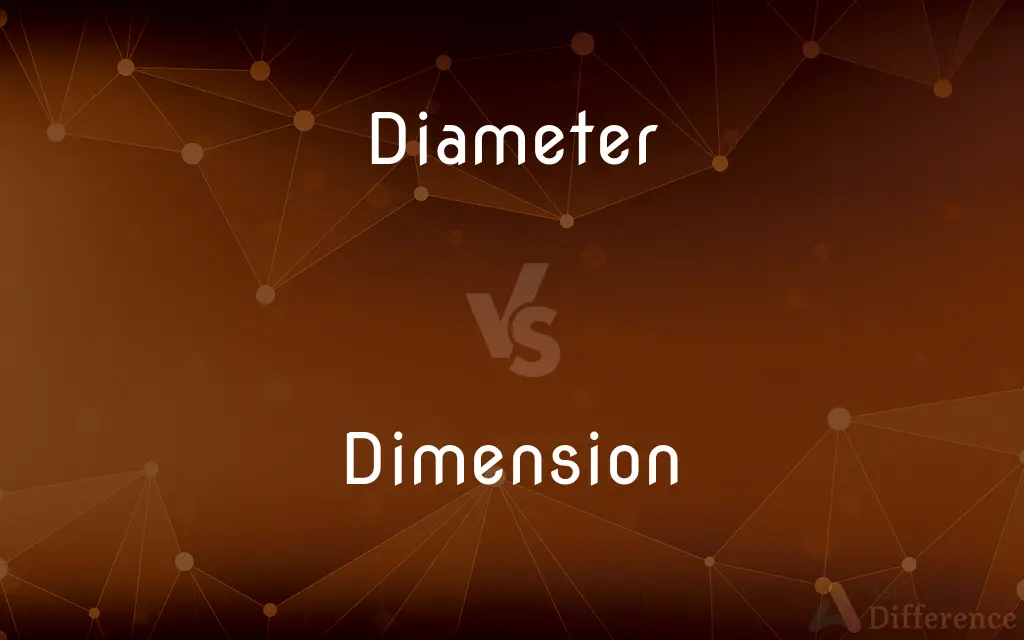Diameter vs. Dimension — What's the Difference?
By Tayyaba Rehman & Urooj Arif — Updated on March 1, 2024
Diameter refers to a straight line passing through the center of a circle, touching two points on its perimeter, while dimension denotes a measure of any aspect such as length, width, or height in a space.

Difference Between Diameter and Dimension
Table of Contents
ADVERTISEMENT
Key Differences
Diameter specifically applies to the measurement across a circle, going through its center, indicating the circle's largest distance. It's a key concept in geometry, representing the width of the circle. Dimension, on the other hand, encompasses broader measurements, not limited to circular objects. It refers to any measurable extent, such as the three-dimensional measures of length, width, and height.
Diameter is a term used within specific contexts, mainly in geometry to describe the distance across a circle, dimension is utilized across various fields including mathematics, physics, and everyday language to describe the size or extent of objects. Dimensions define the proportions and can apply to lines, surfaces, and volumes, making the concept universally applicable.
The concept of diameter is integral to calculating the circumference and area of a circle, relying on the formulae involving pi (π). This specific measure helps in understanding and visualizing the scale of circular objects. Dimensions, conversely, are essential for describing the physical space an object occupies and are crucial for calculations in physics, engineering, and daily life, such as in construction and spatial planning.
Diameter is measured in linear units such as millimeters, centimeters, inches, or feet, similar to one aspect of dimensions. However, dimensions can extend to include units of measure in multiple directions (e.g., cubic meters for volume), reflecting the complexity and variety of space that dimensions can describe.
Both diameter and dimension are fundamental to understanding and describing the space and size of objects, diameter is a specific measurement related to circles, and dimension is a more versatile and comprehensive term that describes the measure of any space or object.
ADVERTISEMENT
Comparison Chart
Definition
The longest straight line that can be drawn through the center of a circle, connecting two points on its circumference.
A measure of any aspect such as length, width, height, or depth in any space.
Application
Specifically used to describe a feature of circular objects.
Used universally to describe size or extent in various contexts.
Units of Measure
Linear units (e.g., mm, cm, inches).
Linear, square, cubic units, etc., depending on the context (e.g., mm, cm², m³).
Calculation Relevance
Crucial for calculating circle properties (area, circumference).
Essential for determining volume, area, and other spatial properties.
Fields of Use
Primarily geometry.
Mathematics, physics, engineering, and everyday contexts.
Compare with Definitions
Diameter
The width of a circular object.
Measure the diameter of the tree trunk.
Dimension
In physics, referring to the measurable extents of the universe.
The fourth dimension is often described as time.
Diameter
A term used in geometry to describe a specific linear distance.
The diameter is twice the radius.
Dimension
A concept describing the extent of a space or object.
We need the dimensions of the box for shipping.
Diameter
The length of a straight line passing from side to side through the center of a circle.
The diameter of the wheel is 16 inches.
Dimension
Essential in describing the scale of objects.
The bridge’s dimensions are crucial for safety analysis.
Diameter
A key dimensional feature in circular geometry.
The formula for the area of a circle involves its diameter.
Dimension
A measure of length, width, or height of an object.
The room's dimensions are 12x15 feet.
Diameter
A measurement used to express the size of round objects.
The pipe has a diameter of 2 centimeters.
Dimension
A term used to specify the size in various directions.
Check the dimensions of the furniture before buying.
Diameter
In geometry, a diameter of a circle is any straight line segment that passes through the center of the circle and whose endpoints lie on the circle. It can also be defined as the longest chord of the circle.
Dimension
In physics and mathematics, the dimension of a mathematical space (or object) is informally defined as the minimum number of coordinates needed to specify any point within it. Thus a line has a dimension of one (1D) because only one coordinate is needed to specify a point on it – for example, the point at 5 on a number line.
Diameter
A straight line segment passing through the center of a figure, especially of a circle or sphere, and terminating at the periphery.
Dimension
A measurable extent of a particular kind, such as length, breadth, depth, or height
The drawing must be precise in dimension
The final dimensions of the pond were 14 ft x 8 ft
Diameter
The length of such a segment.
Dimension
An aspect or feature of a situation
We must focus on the cultural dimensions of the problem
Diameter
A unit of magnification equal to the number of times an object's linear dimensions is increased by the magnifying apparatus.
Dimension
A measure of spatial extent in a particular direction, such as height, width or breadth, or depth.
Diameter
Any right line passing through the center of a figure or body, as a circle, conic section, sphere, cube, etc., and terminated by the opposite boundaries; a straight line which bisects a system of parallel chords drawn in a curve.
Dimension
Indicate the dimensions on;
These techniques permit us to dimension the human heart
Diameter
The length of a straight line through the center of an object from side to side; width; thickness; as, the diameter of a tree or rock.
Dimension
Shape or form to required dimensions
Diameter
The distance through the lower part of the shaft of a column, used as a standard measure for all parts of the order. See Module.
Diameter
The length of a straight line passing through the center of a circle and connecting two points on the circumference
Diameter
A straight line connecting the center of a circle with two points on its perimeter (or the center of a sphere with two points on its surface)
Common Curiosities
Are dimensions always physical?
While dimensions often refer to physical measures, they can also describe conceptual spaces, such as in mathematics or physics.
What is the diameter of a circle?
The diameter is the longest straight line that can be drawn through the center of a circle, connecting two points on its circumference.
Can diameter be considered a dimension?
Yes, diameter can be considered a specific type of dimension that applies to circular objects.
Can dimensions include depth?
Yes, dimensions can include depth, adding a third aspect to length and width, especially in the context of three-dimensional objects.
How does dimension differ from diameter?
Dimension refers to any measurable extent, such as length, width, or height, in any space, whereas diameter is specifically the measurement across a circle through its center.
What units are used for dimensions?
Dimensions can be measured in units such as millimeters, centimeters, meters, inches, or feet, depending on the context.
How do you measure diameter?
Diameter can be measured using tools like calipers or rulers, by measuring across the circle through its central point.
Can diameter be applied to shapes other than circles?
While diameter specifically refers to circles, similar concepts like width or thickness can apply to other shapes.
Why is diameter important?
Diameter is important for calculating the circumference and area of circles, essential in various applications from construction to manufacturing.
What is the significance of the fourth dimension?
In physics and mathematics, the fourth dimension is often referred to as time, adding a temporal component to the three spatial dimensions.
How do dimensions affect design and construction?
Dimensions are critical in design and construction, determining the size, space, and compatibility of structures and components.
How do you convert diameter to radius?
You can convert diameter to radius by dividing the diameter by two, since the radius is half the diameter.
Is dimension used in science other than physics?
Yes, dimension is a concept used in various branches of science, including chemistry, biology, and environmental science, to describe spatial or temporal scales.
How do dimensions impact shipping and packaging?
Dimensions are crucial for shipping and packaging, determining the space required and the cost based on size and volume.
Do dimensions have a role in digital environments?
In digital environments, dimensions play a key role in defining screen sizes, layout proportions, and virtual spaces in simulations and games.
Share Your Discovery

Previous Comparison
Puce vs. Mauve
Next Comparison
Motivation vs. DriveAuthor Spotlight
Written by
Tayyaba RehmanTayyaba Rehman is a distinguished writer, currently serving as a primary contributor to askdifference.com. As a researcher in semantics and etymology, Tayyaba's passion for the complexity of languages and their distinctions has found a perfect home on the platform. Tayyaba delves into the intricacies of language, distinguishing between commonly confused words and phrases, thereby providing clarity for readers worldwide.
Co-written by
Urooj ArifUrooj is a skilled content writer at Ask Difference, known for her exceptional ability to simplify complex topics into engaging and informative content. With a passion for research and a flair for clear, concise writing, she consistently delivers articles that resonate with our diverse audience.













































